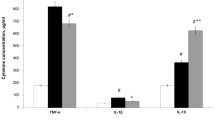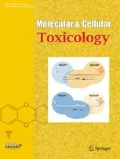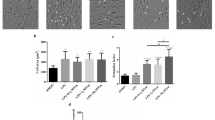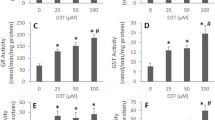Abstract
Background
Oxidative stress is involved in the development of many inflammatory, metabolic and aging diseases.
Objective
In this study we investigated, the protective effects of H2 on RAW 264.7 macrophage cell against LPS-and H2O2-induced oxidative stress by the inhibition of MAPK pathway and also activate the Nrf2 pathway.
Results
Our results showed H2 increased the macrophage cell proliferation and generated ROS and NO against LPS stimulation to exert an active immune response. Similarly, H2 protected the macrophage cell from H2O2-induced oxidative stress. H2 reduced the LPS-and H2O2-induced inflammatory cytokine production and intracellular calcium influxes. H2 inhibited the LPS-and H2O2-induced phosphorylation of MAPK pathway and its downstream signaling molecules. Furthermore, H2 protected the macrophage cell from mitochondrial apoptosis. H2 increased Nrf2 protein expression indicating its strong anti-oxidative effects against oxidative stress.
Conclusion
Collectively, our results indicate the strong antioxidant role of H2 against LPS-and H2O2-induced oxidative stress on macrophage cells by activating the Nrf2 pathway and inhibiting the MAPK-signaling pathway.
Graphic Abstract
Our results clearly showed that LPS increased the cellular ROS by recognizing the TLR4 and H2O2 rapidly increased the cellular (1) and mitochondrial (2) oxidative stress. Excessive ROS/NO molecules cause intracellular calcium influxes (3) As a results imbalance the cellular membrane homeostasis and activate the stress response MAPK signaling pathway with its downstream signaling protein and mitochondrial caspase protein (4) that collapse the anti-oxidant mechanisms and induced the inflammatory cytokine secretion; leads to cell apoptosis (5) Whether H2 reduced the cellular and mitochondrial oxidative stress, intracellular calcium influxes and inhibits the stress response MAPK, caspase cell signaling pathway through the activation of Nrf2/ARE signaling pathway (6) Consequently, increased the antioxidant enzymes and reduced the inflammatory cytokine that influences the macrophage cell proliferation (7) to protect the cell from apoptosis. The different effects of ROS and H2 used in this study are indicated in red and green, red arrow depicts ROS effects in the cell, green arrow depicts H2 effects.











Similar content being viewed by others

References
Arango Duque G, Descoteaux A (2014) Macrophage cytokines: involvement in immunity and infectious diseases. Front Immunol 5:491
Benoit M, Desnues B, Mege JL (2008) Macrophage polarization in bacterial infections. J Immunol 181:3733–3739
Birben E, Sahiner UM, Sackesen C, Erzurum S, Kalayci O (2012) Oxidative stress and antioxidant defense. World Allergy Organ J 5:9–19
Chen HG et al (2013) Heme oxygenase-1 mediates the anti-inflammatory effect of molecular hydrogen in LPS-stimulated RAW 264.7 macrophages. Int J Surg 11:1060–1066
Chuderland D, Seger R (2008) Calcium regulates ERK signaling by modulating its protein-protein interactions. Commun Integr Biol 1:4–5
Cohen J (2002) The immunopathogenesis of sepsis. Nature 420:885–891
Di Marzo N, Chisci E, Giovannoni R (2018) The role of hydrogen peroxide in redox-dependent signaling: Homeostatic and pathological responses in mammalian cells. Cells 7:156
Di Meo S, Reed TT, Venditti P, Victor VM (2016) Role of ROS and RNS sources in physiological and pathological conditions. Oxid Med Cell Longev 2016:1245049
Dinarello CA (1997) Proinflammatory and anti-inflammatory cytokines as mediators in the pathogenesis of septic shock. Chest 112:321s–329s
Ding M, Zhao J, Bowman L, Lu Y, Shi X (2010) Inhibition of AP-1 and MAPK signaling and activation of Nrf2/ARE pathway by quercitrin. Int J Oncol 36:59–67
Ermak G, Davies KJ (2002) Calcium and oxidative stress: from cell signaling to cell death. Mol Immunol 38:713–721
Ge L, Yang M, Yang NN, Yin XX, Song WG (2017) Molecular hydrogen: a preventive and therapeutic medical gas for various diseases. Oncotarget 8:102653–102673
Ichihara M, Sobue S, Ito M, Ito M, Hirayama M, Ohno K (2015) Beneficial biological effects and the underlying mechanisms of molecular hydrogen-comprehensive review of 321 original articles. Med Gas Res 5:1–21
Ighodaro OM, Akinloye OA (2018) First line defence antioxidants-superoxide dismutase (SOD), catalase (CAT) and glutathione peroxidase (GPX): their fundamental role in the entire antioxidant defence grid. Alex J Med 54:287–293
Itoh T et al (2011) Molecular hydrogen inhibits lipopolysaccharide/interferon gamma-induced nitric oxide production through modulation of signal transduction in macrophages. Biochem Biophys Res Commun 411:143–149
Kawamura T et al (2010) Inhaled hydrogen gas therapy for prevention of lung transplant-induced ischemia/reperfusion injury in rats. Transplantation 90:1344–1351
Kensler TW, Wakabayashi N, Biswal S (2007) Cell survival responses to environmental stresses via the Keap1-Nrf2-ARE pathway. Annu Rev Pharmacol Toxicol 47:89–116
Kim EK, Choi EJ (2010) Pathological roles of MAPK signaling pathways in human diseases. Biochim Biophys Acta 1(802):396–405
Kura B, Bagchi AK, Singal PK, Barancik M, LeBaron TW, Valachova K, Šoltés L, Slezák J (2018) Molecular hydrogen: potential in mitigating oxidative-stress-induced radiation injury. Can J Physiol Pharm 97:287–292
Kurokawa R, Seo T, Sato B, Hirano S, Sato F (2015) Convenient methods for ingestion of molecular hydrogen: drinking, injection, and inhalation. Med Gas Res 5:13
Liguori I et al (2018) Oxidative stress, aging, and diseases. Clin Interv Aging 13:757–772
McCoy CE, O’Neill LA (2008) The role of toll-like receptors in macrophages. Front Biosci 13:62–70
Muñoz Carrillo JL, Castro García FP, Gutiérrez Coronado O, Moreno García MA, Contreras Cordero JF (2017) In: Rezaei N (ed) Physiology and pathology of immunology. IntechOpen, London, pp 99–134
Murakami Y, Ito M, Ohsawa I (2017) Molecular hydrogen protects against oxidative stress-induced SH-SY5Y neuroblastoma cell death through the process of mitohormesis. PLoS One 12:e0176992
Nagai H, Noguchi T, Takeda K, Ichijo H (2007) Pathophysiological roles of ASK1-MAP kinase signaling pathways. J Biochem Mol Biol 40:1–6
Niture SK, Khatri R, Jaiswal AK (2014) Regulation of Nrf2-an update. Free Radic Biol Med 66:36–44
Ohno K, Ito M, Ichihara M, Ito M (2012) Molecular hydrogen as an emerging therapeutic medical gas for neurodegenerative and other diseases. Oxid Med Cell Longev 2012:353152
Ohsawa I et al (2007) Hydrogen acts as a therapeutic antioxidant by selectively reducing cytotoxic oxygen radicals. Nat Med 13:688–694
Ohta S (2011) Recent progress toward hydrogen medicine: potential of molecular hydrogen for preventive and therapeutic applications. Curr Pharm Des 17:2241–2252
Ohta S (2014) Molecular hydrogen as a preventive and therapeutic medical gas: initiation, development and potential of hydrogen medicine. Pharmacol Ther 144:1–11
Orrenius S, Gogvadze V, Zhivotovsky B (2015) Calcium and mitochondria in the regulation of cell death. Biochem Biophys Res Commun 460:72–81
Redza-Dutordoir M, Averill-Bates DA (2016) Activation of apoptosis signalling pathways by reactive oxygen species. Biochim Biophys Acta 1863:2977–2992
Senger DR, Li D, Jaminet SC, Cao S (2016) Activation of the Nrf2 cell defense pathway by ancient foods: disease prevention by important molecules and microbes lost from the modern western diet. PLoS One 11:e0148042
Shao A et al (2016) Hydrogen-rich saline attenuated subarachnoid hemorrhage-induced early brain injury in rats by suppressing inflammatory response: possible involvement of NF-κB pathway and NLRP3 inflammasome. Mol Neurobiol 53:3462–3476
Shaughnessy LM, Swanson JA (2007) The role of the activated macrophage in clearing Listeria monocytogenes infection. Front Biosci 12:2683–2692
Son Y et al (2011) Mitogen-activated protein kinases and reactive oxygen species: how can ROS activate MAPK pathways? J Signal Transduct 2011:792639
Son Y, Kim S, Chung HT, Pae HO (2013) Reactive oxygen species in the activation of MAP kinases. Methods Enzymol 528:27–48
Sun Q et al (2009) Hydrogen-rich saline protects myocardium against ischemia/reperfusion injury in rats. Exp Biol Med (Maywood) 234:1212–1219
Tian Y et al (2017) Effects of hydrogen-rich saline on hepatectomy-induced postoperative cognitive dysfunction in old mice. Mol Neurobiol 54:2579–2584
Xie K et al (2010) Protective effects of hydrogen gas on murine polymicrobial sepsis via reducing oxidative stress and HMGB1 release. Shock 34:90–97
Yuan J, Wang D, Liu Y, Chen X, Zhang H, Shen F, Liu X, Fu J (2018) Hydrogen-rich water attenuates oxidative stress in rats with traumatic brain injury via Nrf2 pathway. J Surg Res 228:238–246
Author information
Authors and Affiliations
Contributions
RB and CSK contributed equally to this work; RB performed most of the experiments, analyzed the results, interpreted the data, wrote and revised the whole manuscript; CSK planned, supervised the whole study, performed the experiment, interpreted the results and revised the manuscript; AF and JB performed the experiments, analyzed the results, and revised the manuscript; XJ performed the experiment and revised the manuscript; DHK revised the manuscript; SKK suggested the plan and revised the manuscript; KJL conceived, supervised and supported the whole study, and revised the whole manuscript.
Corresponding author
Ethics declarations
Conflict of interest
Rahima Begum, Cheol-Su Kim, Ailyn Fadriquela, Johny Bajgai, Xingyu Jing, Dong-Heui Kim, Soo-Ki Kim and Kyu-Jae Lee that they have no conflict of interest.
Ethical approval
The article does not contain any studies with human and animal and this study was performed following institutional and national guidelines.
Additional information
Publisher’s Note
Springer Nature remains neutral with regard to jurisdictional claims in published maps and institutional affiliations.
Electronic supplementary material
Below is the link to the electronic supplementary material.
Rights and permissions
About this article
Cite this article
Begum, R., Kim, CS., Fadriquela, A. et al. Molecular hydrogen protects against oxidative stress-induced RAW 264.7 macrophage cells through the activation of Nrf2 and inhibition of MAPK signaling pathway. Mol. Cell. Toxicol. 16, 103–118 (2020). https://doi.org/10.1007/s13273-020-00074-w
Accepted:
Published:
Issue Date:
DOI: https://doi.org/10.1007/s13273-020-00074-w



